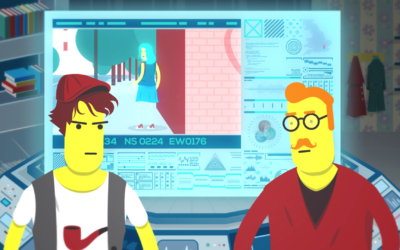Terms & Conditions
Author: Andrea Wallace
Illustration: Davide Bonazzi
Introduction: Terms of Use of CopyrightUser.org
Almost all content on Copyright User’s website is distributed under a CC-BY 3.0 licence, the most flexible Creative Commons licence. The CC-BY licence allows you to share, remix, alter, and build upon Copyright User content for any purpose, as long as you credit Copyright User for the original creation.
This means Copyright User’s website content can be used on another website, for a song remix, or any type of commercial use. All you need to do is attribute the content you use to its creator(s) and acknowledge CopyrightUser.org as the source.
Where content on Copyright User is not distributed under a CC-BY 3.0 licence, this will be indicated clearly.
Website terms and conditions explained
Terms and conditions are a set of rules. These rules generally form a contract between you, the user, and the service provider, whose website you are visiting. The terms of that contract are set out in the website’s terms and conditions, which explain what you are and are not permitted to do on the website and with its content.
Terms and conditions assist service providers in two ways: in setting out ownership rights over a website’s content and in defining what type of access and (re)use is permitted for visitors.
Where terms and conditions are located
Terms and conditions are often found in the “Terms of Use” section of a website, but not always. In fact, the rules can be contained anywhere on a website and called anything from “Legal Notice” to “Permissions” to “Website Policy.” Where the terms and conditions are located is not always obvious or intuitive.
As a website visitor, you have a responsibility to locate and understand how a website’s terms and conditions apply to your access and use. Not only are these rules usually legally binding, but they generally apply to you and your use of a website regardless of whether you are aware of them.
Restrictions and ownership of online content
A website’s terms and conditions are often drafted in legal language to protect the service provider’s investment in the website and any relevant intellectual property rights. Because of this, terms and conditions are not always easy to understand, especially for the average user.
The terms and conditions may address several topics such as:
• Definitions of website “content” and what is protected
• A copyright statement
• A public domain statement
• Ownership of text and data content
• Ownership of metadata
• Permissions (or not) for reuse, including for commercial or noncommercial purposes
• Conditions for permitted reuse
• Contact information for licensing of website content
• Disclaimers, waivers and indemnification procedures
• Enforcement policies in the case of infringement
• Privacy and cookies policies
Ideally, websites should set out exactly what is permitted by the service provider, in language that is clear, authoritative and easy to understand. A provider should be upfront about the type of access and reuse allowed in order to dispel doubts toward what constitutes a violation of the terms. In addition, providing citation information for attribution to the website for reuse is especially helpful. Clear and unambiguous information not only provides the user with greater certainty about what is permitted, but also encourages respectful and lawful access and reuse.
Permissions for access and use
As discussed elsewhere, it is important to get permission to use someone else’s creative work. Doing so is not only legally required, but it is also respectful of the creator who took the time and effort to make the content. Usually, these permissions are contained in the terms and conditions and they detail not only how you are permitted to use website content, but also what qualifies as usable content and for what purpose. Violating the terms and conditions could expose you to a lawsuit.
In some cases, the need to ask for permission to make use of the work may be entirely waived. This information will also be contained in the terms and conditions. For example, several cultural institutions make available online digital reproductions of public domain works at a high resolution, which can be used for any purpose without the institution’s permission. A few of these institutions include the Rijksmuseum, the John Paul Getty Museum, the Library of Congress, the British Library, the Yale Center for British Art, and the Museum of New Zealand Te Papa Tongarewe.
In each case, however, this information is drafted in a different way and contained in a different part of the website. Access is also extended in various ways.
For example, the Rijksmuseum enables access through the creation of a Rijksstudio account, which permits users to download images of public domain works in its collection. Images provided through the Rijksstudio can be used for any purposes, even commercial purposes. While this fact is generally widely known in the museum sector, the terms, however, are a bit difficult for a user to find. First, the institution’s terms of use are only accessible via the “Organisation” page, rather than through the main museum website or the Rijksstudio. Clicking on “Terms” directs the user to a page that includes the heading “Terms and conditions website.” Directly under this heading is a link. Clicking it downloads directly to the user’s hard drive a pdf document titled “TERMS AND CONDITIONS GOVERNING THE USE OF THE RIJKSMUSEUM AMSTERDAM WEBSITE.” The result is that the Rijksmuseum’s terms and conditions for use of its websites are, in actuality, not located on the museum’s website.
Compare this to the Museum of New Zealand Te Papa Tongarewe. The museum’s terms are accessible via a link in the museum’s homepage footer, “Copyright and terms of use.” Not only is the policy drafted in everyday language, but a user browsing through the online collection is able to see directly beneath each image whether the image is in copyright or in the public domain, as well as what permissions apply. As the user goes through the process of downloading the image, the museum takes additional steps to clarify whether attribution is required, and, if so, provides the proper citation for the work.
It is important to remember, however, that not all website terms and conditions permit use. Many expressly prohibit any type of reuse whatsoever without permission from the website provider, including use of content that is normally in the public domain. Ultimately, it is your responsibility as a user to ensure you understand and respect a website’s terms and conditions during access and (re)use.
Terms and Conditions and Exceptions to Copyright
While many website terms and conditions expressly prohibit any type of reuse whatsoever without permission from the provider, it is important to appreciate that there are certain exceptions to copyright that cannot be precluded by any form of contract. This means regardless of what the terms and conditions may prohibit, use of copyright-protected material conforming to a UK copyright exception will be permitted by law. Terms and conditions, and other types of contracts, cannot override those copyright exceptions.
Some of the exceptions that cannot be overridden by contract terms include exceptions for text and data mining, research and private study, parody, quotation, criticism and review. More information about the criteria required to meet each exception is provided on each exception’s page.
How to Acknowledge the Content of CopyrightUser.org
For the purposes of this website, Copyright User is happy for you to use the website’s content in any way (unless otherwise stated), so long as you acknowledge the creator(s) of the content you use and CopyrightUser.org as the source. We understand this can get tricky, considering the differences in the various types of content we make available on this website, such as texts, illustrations, and videos. For clarification, we’ve included a few examples below based on the Text & Data Mining page and the video The Game is On! – Episode 1: The Adventure of the Girl with the Light Blue Hair.
When using texts (or portions of them), please provide the following acknowledgment:
[Page Title]. Commentary by [Author] for CopyrightUser.org. This work is in copyright and available to use under the CC BY 3.0 licence. Source: [webpage address]
As applied to the example, the acknowledgement should read:
Text & Data Mining. Commentary by Maurizio Borghi for CopyrightUser.org. This work is in copyright and available to use under the CC BY 3.0 licence. Source: https://www.copyrightuser.org/understand/exceptions/text-data-mining/
When using illustrations, please provide the following attribution to the author of our illustrations, Davide Bonazzi:
[Page Title]. Illustration by Davide Bonazzi for CopyrightUser.org. This work is in copyright and available to use under the CC BY 3.0 licence. Source: [webpage address]
As applied to the example, the acknowledgement should read:
Text & Data Mining. Illustration by Davide Bonazzi for CopyrightUser.org. This work is in copyright and available to use under the CC BY 3.0 licence. Source: https://www.copyrightuser.org/understand/exceptions/text-data-mining/
When using videos:
Credits of the videos can be found within the videos themselves (in the last frame) and/or on the webpage where the video is embedded. Whenever practical, full video credits should be provided. If it is not possible to provide full acknowledge for reasons of practicality, the director and producer of the video as well as CopyrightUser.org should be acknowledged.
As applied to the example, the full acknowledgement should read:
The Game is On! – Episode 1: The Adventure of the Girl with the Light Blue Hair
Written, Directed and Produced for CopyrightUser.org by Ronan Deazley and Bartolomeo Meletti
Art Direction / Design / Animation: Marco Bagni
Illustrations: Davide Bonazzi
Music / SFX: Sarc:o
Voice-over Artists (londonvoiceover.co.uk): Joseph – Vincent Brimble; Sherlock Homes – Cliff Chapman; John Watson – Anton Saunders
This work is in copyright and available to use under the CC VY 3.0 licence. Source: https://www.copyrightuser.org/schools/the-game-is-on/
As applied to the example, the short acknowledgement should read:
The Adventure of the Girl with the Light Blue Hair. Written, directed and produced for CopyrightUser.org by Ronan Deazley and Bartolomeo Meletti. This work is in copyright and available for use under the CC BY 3.0 licence. Source: https://www.copyrightuser.org/educate/the-game-is-on/
References
Terms of Service; Didn’t Read: a user’s rights initiative that rates and labels website terms and privacy policies for major service providers, such as Facebook, Google, and twitter – https://tosdr.org/
The Creative Commons: a webpage that allows you to browse and select a CC-licence best suited for your website and needs – https://creativecommons.org/licenses/
Europeana, Public Domain Usage Guidelines and Usage Guidelines for Metadata: provides an example of everyday language in online policies that promotes transparency and public awareness –
http://www.europeana.eu/portal/rights/public-domain.html
http://www.europeana.eu/portal/rights/metadata.html
The Surrogate IP Rights Blog, “How to Design a ‘Good’ IP Policy”: offers advice for cultural institutions on how to draft accessible terms and conditions for use of online content – http://surrogateiprights.org/how-to-design-a-good-ip-policy/
Related
The Game is On! – Ep. 1
In a fictional land called London, Sherlock Holmes and John Watson meet a curious client: the toymaker Joseph …
Public Domain: Duration
This commentary explains how long copyright lasts and what you need to consider when calculating the copyright term of different types of works.
Getting Permission
When you want to use a work that is in copyright, you need to get permission from all copyright owners. Some works have several rights attached to them and each right may have more than one owner…











